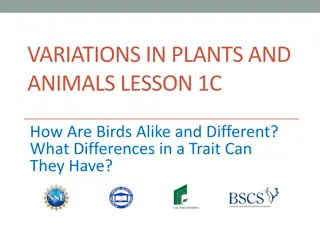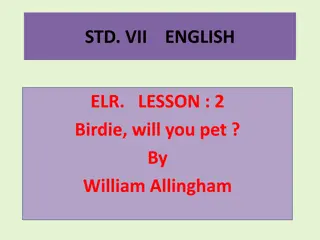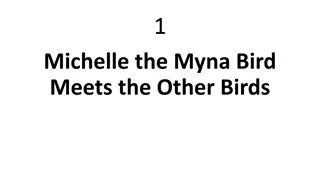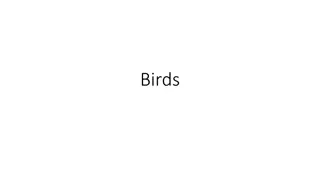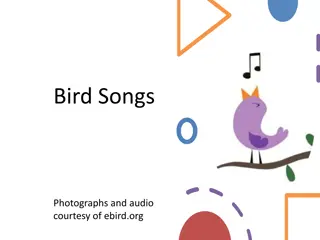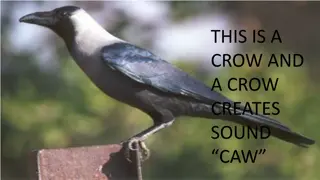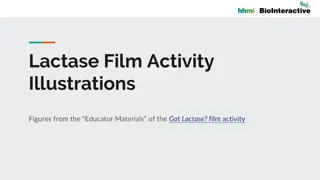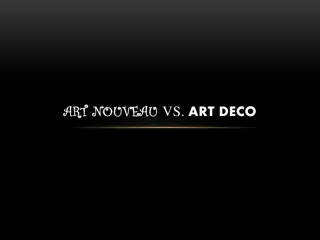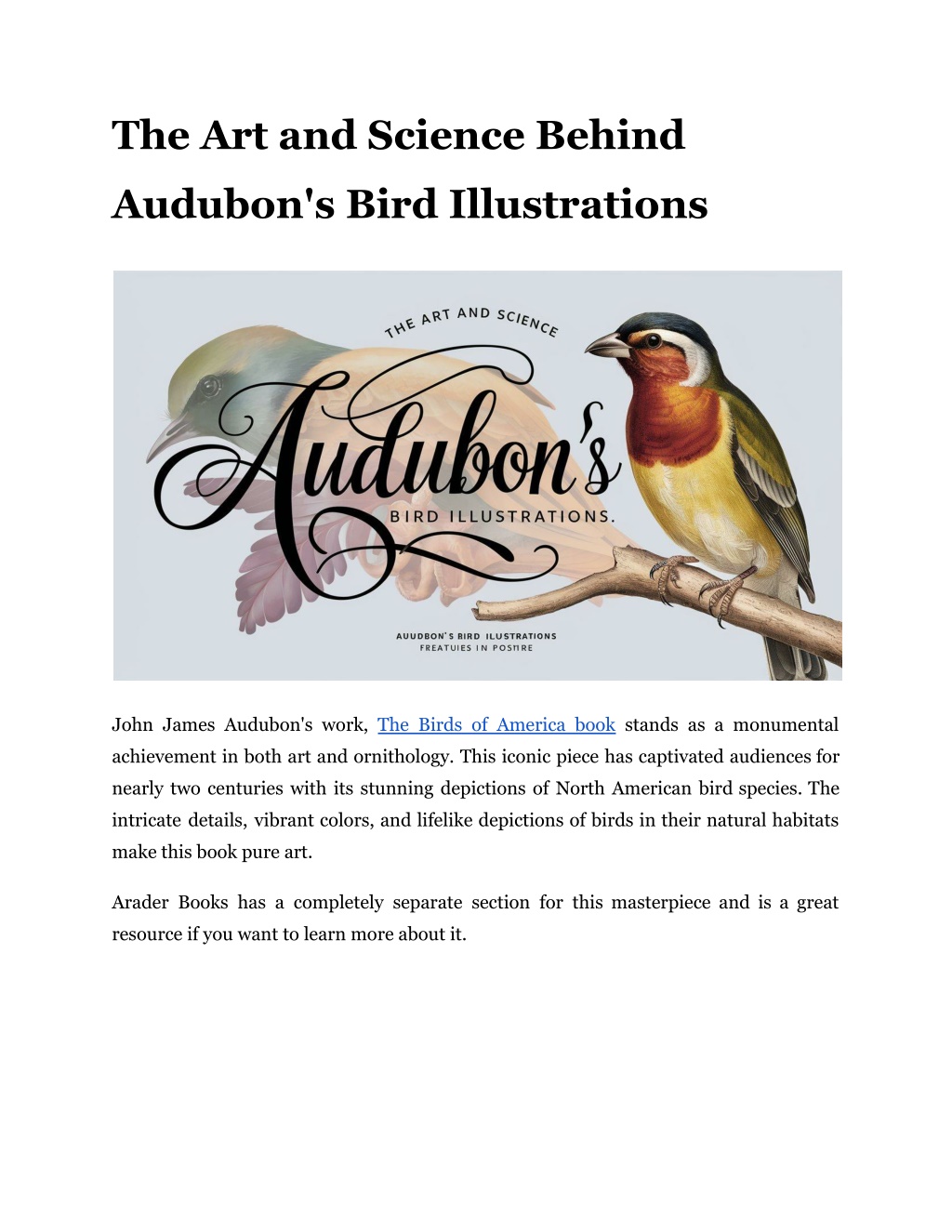
The Art and Science Behind Audubon's Bird Illustrations
Explore the intricate art and scientific accuracy of Audubon's bird illustrations. Discover the techniques and passion behind his iconic works.n
Download Presentation

Please find below an Image/Link to download the presentation.
The content on the website is provided AS IS for your information and personal use only. It may not be sold, licensed, or shared on other websites without obtaining consent from the author. Download presentation by click this link. If you encounter any issues during the download, it is possible that the publisher has removed the file from their server.
E N D
Presentation Transcript
The Art and Science Behind Audubon's Bird Illustrations John James Audubon's work, The Birds of America book stands as a monumental achievement in both art and ornithology. This iconic piece has captivated audiences for nearly two centuries with its stunning depictions of North American bird species. The intricate details, vibrant colors, and lifelike depictions of birds in their natural habitats make this book pure art. Arader Books has a completely separate section for this masterpiece and is a great resource if you want to learn more about it.
The Creation of Audubon's Birds Of America A Visionary Artist Born in Haiti in 1785 and raised in France, Audubon immigrated to the United States in his early twenties. His passion for nature and art led him to embark on an ambitious project: to document every bird species in North America. Over 14 years, Audubon traveled extensively across the continent, from the Atlantic coast to the Mississippi River, meticulously studying and sketching birds in their natural habitats. His dedication to capturing the essence of each species is evident in the dynamic poses and vivid colors of his illustrations. Innovative Techniques Audubon Birds Of America Book s artistic process was groundbreaking for its time. He employed a technique known as "life drawing," where he would observe birds in the wild, often killing them to pose them for his artwork. This method allowed him to capture intricate details of anatomy and behavior that were previously unseen in scientific illustrations. He used fine shots to minimize damage to the specimens, threading wire through the bodies to create lifelike poses. The prints in The Birds of America book were produced using the Havell engraving technique, which involved hand-engraving copper plates and then hand-coloring each print. This labor-intensive process resulted in incredibly detailed images that were larger than life, measuring approximately 40 inches by 28 inches. The sheer scale of the prints allowed Audubon to depict birds at life-size, a revolutionary approach in ornithological illustration. Read More Articles: Perfect Day Trips: Tours and Itineraries for Exploring Barossa Valley Wineries
The Impact of Size and Detail The size and detail of the illustrations set it apart from previous works. Audubon s decision to portray birds in action, rather than in static poses against a plain background, brought a sense of vitality and realism that captivated audiences. For instance, his depiction of the American Flamingo shows the bird bending down to feed, highlighting its distinctive features and behaviors in a natural setting. This approach not only showcased the beauty of the birds but also educated viewers about their habits and environments. The Intersection of Art and Science Scientific Contributions Audubon's work transcends mere artistic expression; it serves as a vital scientific resource. His illustrations provided some of the earliest documentation of many bird species, including those that have since become extinct, such as the Ivory-Billed Woodpecker and the Carolina Parakeet. The detailed observations included in his writings, such as body measurements, behaviors, and habitats, contributed significantly to the field of ornithology. Audubon s notes and illustrations were instrumental in the identification of 25 new species. His commitment to observing birds in their natural environments allowed him to document not only their physical characteristics but also their interactions with the ecosystem. This holistic approach to studying birds laid the groundwork for future ornithological research. Artistic Legacy The artistic legacy of Audubon's Birds Of America is equally profound. His illustrations have inspired countless artists and naturalists, influencing the way birds are depicted in art and science. The aesthetic quality of his work has led to its recognition as a significant contribution to American art, with this book being considered one of the
most valuable illustrated books in the world. A single copy sold for $11.5 million at auction in 2010, underscoring its cultural and financial significance. Audubon's ability to blend scientific accuracy with artistic beauty has set a standard for future generations of naturalists and artists. His work continues to resonate with audiences, inviting them to appreciate the beauty of the natural world. Audubon's Techniques in Detail The Havell Engraving Process The Havell engraving process was a key innovation that allowed Audubon to produce his stunning illustrations. This technique involved the following steps: 1. Drawing: Audubon would create detailed watercolor sketches of the birds he observed. 2. Engraving: Skilled engravers at Robert Havell and Son would transfer these sketches onto copper plates then carve out the designs. 3. Printing: The engraved plates were inked and pressed onto large sheets of handmade paper, resulting in the initial black-and-white prints. 4. Hand-coloring: Each print was then hand-colored, often by a team of artists, to bring the illustrations to life. This multi-step process was labor-intensive and costly, but it resulted in prints that were not only scientifically valuable but also visually striking. Observational Techniques Audubon's observational techniques were revolutionary in the field of natural history. He spent hours in the field, studying birds in their natural habitats. His approach included: Field Notes: Audubon kept detailed notes on bird behavior, feeding habits, and interactions with their environment.
Behavioral Studies: He often depicted birds in dynamic poses, illustrating their behaviors rather than just their physical forms. Environmental Context: Audubon's illustrations often included elements of the birds' habitats, providing context that enriched the viewer's understanding of each species. Read More Articles: How Much Does a Private Jet Cost in Austin? The Cultural Impact of Audubon's Work A Reflection of American Identity Audubon's work reflects the burgeoning American identity of the early 19th century. As the nation expanded westward, there was a growing interest in the natural world and its preservation. Audubon's illustrations captured the diversity of American wildlife at a time when much of the continent was still unexplored. His depictions of birds became emblematic of the American wilderness, inspiring a sense of national pride and connection to nature. The Wrap Up For those interested in exploring the wonders of The Birds of America book or seeking to understand the art and science behind Audubon's illustrations, there is no better place to start than by diving into this extraordinary work. Head over to the Arader Books website and start your research today. Site Article: The Art and Science Behind Audubon's Bird Illustrations










